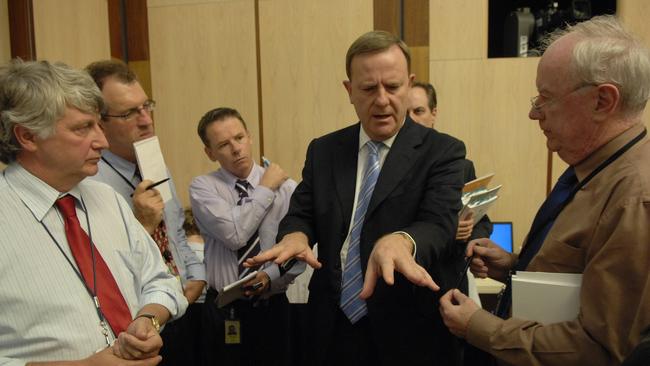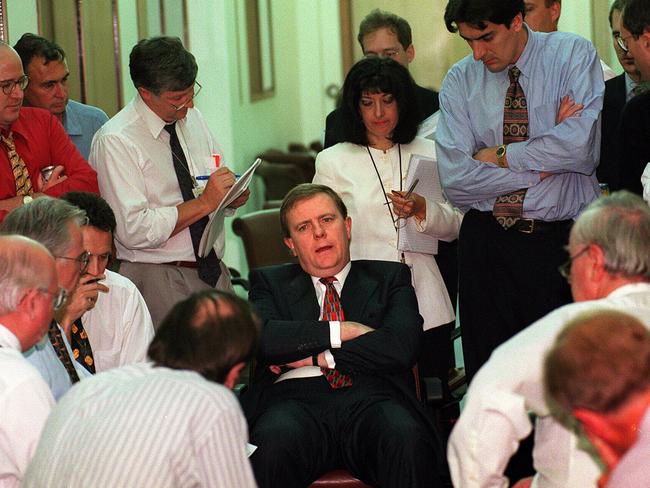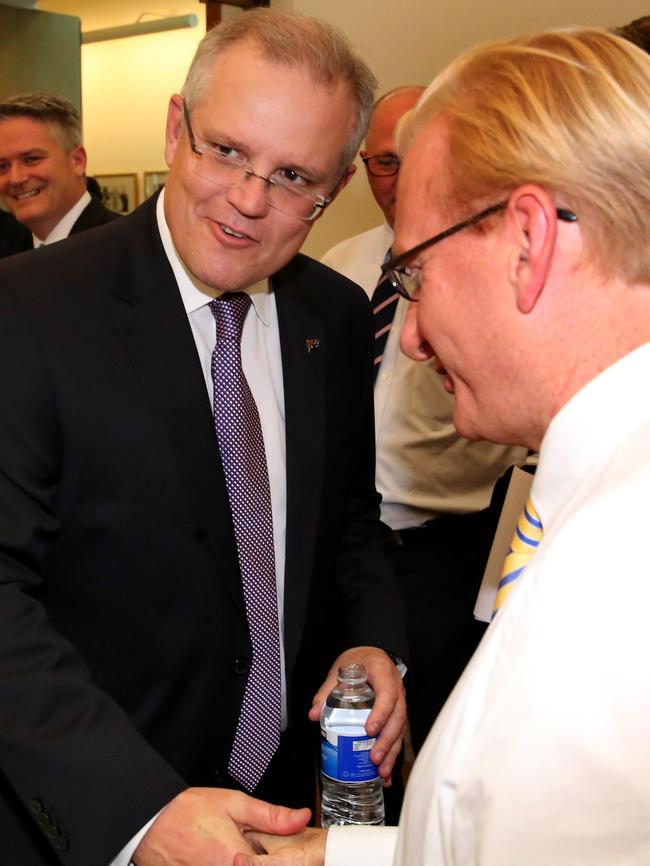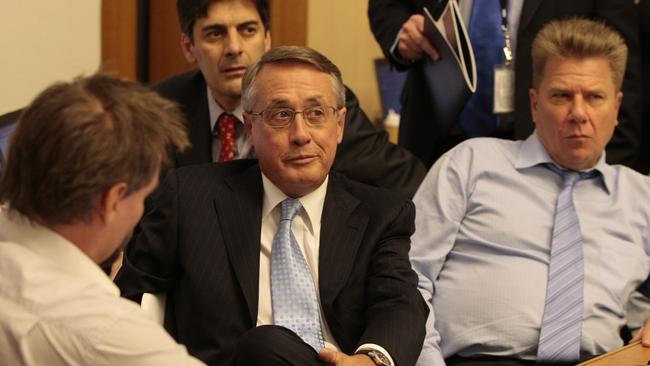Behind the Budget day balancing act
What’s the point of a Budget lock-up these days? The government wants to have its metaphorical wicked way with the media.

The second Tuesday in May: for politics and economics journalists it is as significant as the first Tuesday in November is for the rest of the country.
Tomorrow is budget day, a day when hundreds of the nation’s best journalists are voluntarily locked away in the bowels of federal parliament out of contact with the world for six hours. The point of a lock-up these days? The federal government wants to have its metaphorical wicked way with the media.
There can be no other reason for putting cash-strapped media companies through the expense of the trip to Canberra, overnight accommodation and meals for hundreds of out-of-town journalists: 580 are registered to attend the lock-up this year.
Once budgets were tightly guarded secrets and the lock-up was enforced to ensure no one could profit on the share and money markets from decisions that would not be announced to the parliament until the treasurer’s 7.30pm speech.
But for the last decade most budgets have been so widely leaked it is increasingly difficult to find genuine news in the mass of documents handed out to reporters after they have signed their individual confidentiality agreement witnessed by a Treasury official and handed over their phones and iPads before entry to the lock-up.

All computers inside must be on secure encrypted systems set up specially for that day, so dozens of technical computer support staff are required each year. Reporters and editors in the lock-up can communicate with production journalists locked up at their organisation’s head office, but not with any staff outside these lock-ups until 7.30pm.
All this gives the Treasury a great deal of potential influence over the budget coverage of the media. Newspaper front-page artwork is usually done in advance and based on what has been leaked. Same for most of the print and online graphics.
I used to bristle against doing too much in advance and often rang the legendary Bill Leak at home at 7.30pm to discuss fresh ideas Bill was smart enough to turn around in an hour. This had the advantage of being informed by a full reading of the budget and discussion with Paul Kelly, Judith Sloan, Henry Ergas, Dennis Shanahan and Adam Creighton.
The treasurer of the day usually hated these front pages because they were too accurate, like Bill’s famous “that’s not a knife Treasurer” cartoon of Wayne Swan as a miniature Crocodile Dundee with oyster shucker in one hand and fluffy kids crocodile toy in the other, having again squibbed his promised deep spending cuts.
Treasury has lots of economists roving the various individual media organisations in their assigned rooms. This is to answer questions but also to try to persuade sceptics of the value of various budget measures.
The actual coverage is a finely tuned piece of work. The lock-up chief of staff will assign stories and produce a full news list by 3pm. Reporters know their rounds and hit their computers fast. Many will file five or more stories before 7.30pm.
But like everything in media, this all has its lighter moments.

Journalists are legendary lunchers. So the arrival of pre-ordered hot food is greeted with relief and is an excuse to take to the corridors and discuss policy with diners from other organisations. Coffee, caffeinated soft drinks and high-calorie but delicious food abound as the troops fuel up for the long night ahead. After 7.30pm many of the Canberra and interstate reporters race back to their bureau offices and hit the phones looking for reaction to feed into their stories.
Also in town for the budget are representatives from 300 major business, rural, education, defence and trade union stakeholder groups who are locked up at the Hyatt Hotel. By 7.30pm they will have worked out their take and have their quotes ready to be pumped out on the Australian Associated Press wire service and to take calls from each of the big media groups.
Much has already been done to camera inside the media lock-up and digital teams have been fine-tuning both their pieces to camera and their latest interactive graphics ideas. These are fed into websites at 7.30pm. Editors stay in the lock-up and keep producing pages, generally finishing page one for the first edition by 9.30pm and then going through page proofs and second-edition follows and updating reaction pieces. Many from inside the lock-up will be interviewed by the ABC for 7.30 or ABC 24 and Sky News as soon as they can get to studios on the Senate side of the building.
Journalists will start arriving at their traditional post lock-up dinners at their organisations’ favourite restaurant about 10pm. Editors and backbenchers often will not arrive until closer to midnight and many continue on to bars until early morning. Treasurers, prime ministers and opposition spokespeople like to appear at these dinners for a drink and discussion with each of the media organisations.
What goes on in Canberra stays in Canberra, at least on budget night. Suffice to say, many a reporter and editor has made the early morning flight or bus trip back to Sydney without sleep.
The best performances by treasurers in my 35-plus lock-ups were those of Paul Keating and Peter Costello. They were showmen with the ability to sell an overarching narrative of reform in their budgets, something John Howard said two years ago was missing in many modern politicians. Keating and Costello cultivated senior reporters and editors year in and year out, always pushing messages of reform, growth, competition and national improvement.
Keating got the nation’s finances back in order after the 1981 recession, created the compulsory superannuation guarantee levy in partnership with his political salesman prime minister Bob Hawke and set up modern Australia with two decades of productivity improvements built on a series of accords with the trade union movement to restrain wages. These gave us increasing real living standards until the global financial crisis of 2008.

Costello did not shirk tough decisions and crash-tackled government overspending in his first budget in 1996, which set the Coalition up for a dozen years of government and prosperity. Like his predecessor, he partnered his political salesman PM John Howard in risking all: in their case with the GST election that nearly cost them power in 1998.
Sure, Tony Abbott and Joe Hockey showed courage in their 2014 budget, trying to repair the nation’s finances after three failed Swan budgets in which Labor planned but squibbed structural budget repair. But Hockey talked about lifters and leaners in a speech in London and on Lateline once. The budget’s tough but needed measures were largely blocked by crossbench wreckers and the public was never engaged with the need for spending cuts.
Hockey ditched the restraint the next year and today 60 per cent of all households receive more from the government than they pay in tax. An inattentive media not schooled by the relentless efforts of a Keating or a Costello are only interested in easy stories about the losers of reform. Few are motivated by the national interest.
Budgets are serious, but for journalists budget day always has a lot of funny moments.
At The Australian Financial Review in the early 1980s, editor-in-chief Paddy McGuinness, a notorious budget sprinter who had usually finished his commentary and his editorial before 4pm, marched into the lock-up with two slabs of beer (for the entire AFR lock-up crew, so only a stubby or two each) but no copy paper for reporters to type on. Paddy had to trade beer for paper with the other mastheads.
It will be a hard night for Fairfax journalists. For most papers, the budget edition remains their biggest-selling day of the year. Our thoughts are with those on strike and with the 125 soon to lose their jobs.



